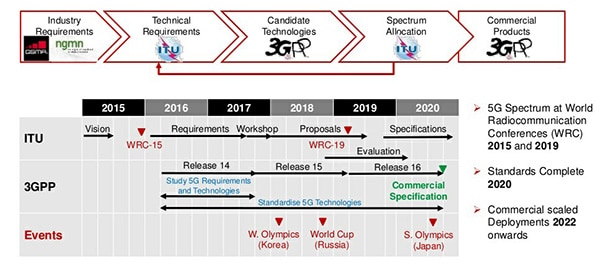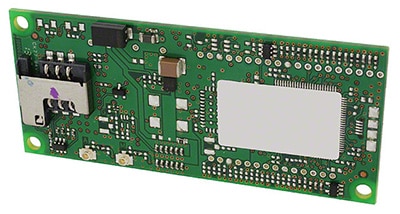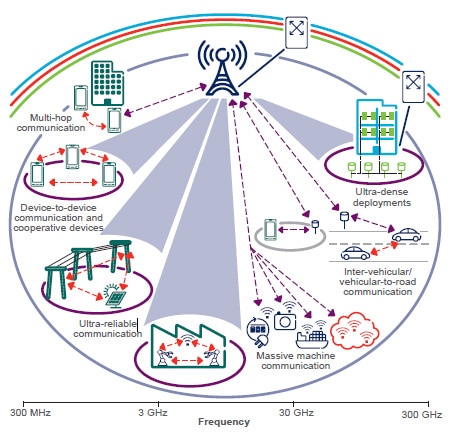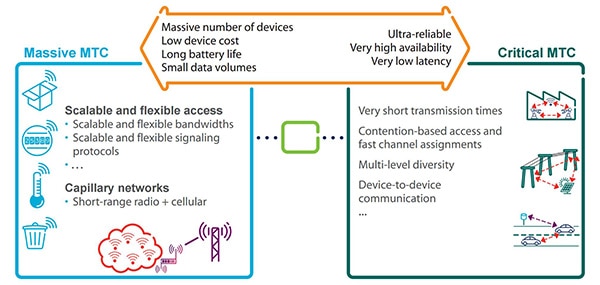How 5G Will Change the Industrial Internet of Things
投稿人:DigiKey 欧洲编辑
2016-03-22
The race is on to develop the next generation of cellular technology, and in contrast with previous systems there is a significant focus on the needs of industrial networks using machine-to-machine (M2M) links in the Internet of Things (IoT).
The protocols and technologies that will be used for 5G networks are still being investigated, with the final standards expected to come together at the end of 2016 and approved by 2018. With much of the advanced work already done, operators are expecting to roll out commercial systems by 2020 based on these standards, with full systems implemented by 2022; so there is an aggressive development and implementation period that will impact developers of IoT systems. This will start with the development of the modem silicon, evolving from the current 4G designs, for smartphones and tablets. That modem silicon will be integrated into modules for easy addition to IoT and M2M designs.
One key difference for the development of 5G systems is that the requirements of the network have been determined well in advance of the technology standards.

Figure 1: The development of standards, technology and networks for 5G is aggressive. Source: GSMA
The requirements of a 5G network will be real data rates of 1 to 10 Gbit/s, rather than theoretical peak rates, coupled with a 1 ms end-to-end latency, which is a key advantage for IoT developers. The wider network will have to support 1000x the bandwidth of today’s cells and 10 to 100 times more devices connected at the same time, which will again allow for many more connected devices of all kinds in the Internet of Things. Like 3G and 4G, the data connections will essentially be ‘always on’ rather than circuit switched, so the ability to support up to 100x more devices is critical, as many more devices will be connecting to the network simultaneously. The networks should have a perceived availability of 99.999%, and a perceived coverage of 100%, trading off data rate for range, which will also help with M2M implementations that need the range but not the data. This helps with the rollout of IoT networks as the nodes can connect directly to the Internet via a 5G basestation, rather than having to use a series of gateways or interface servers that need more sophisticated network planning.
Another factor that will be vital to the roll out of 5G IoT networks is the specification of lower power consumption, as the requirement is for a battery life of ten years or more for the wireless modem. This should open up the opportunity for many more battery-powered wireless IoT nodes, again providing for easier installation.
Frequency bands
However, meeting those requirements will be a challenge. The frequency bands being targeted range from 700 MHz in the bands previously used for analog broadcast TV, up to new bands for cellular links at 3.6 GHz.
The World Radio Congress in 2015 (WRC-15) agreed to a common allocation of 200 MHz of spectrum in the C-band from 3.4 to 3.6 GHz, which was seen as a positive step forward, as this is a new spectrum not previously used for telecoms applications. The WRC-15 also agreed to a harmonized L-band that runs from 1427-1518 MHz, well below the current 2.4 GHz band used by Wi-Fi, Bluetooth and ZigBee
At the same time the 700 MHz band of 694-790 MHz was expanded from US and Asian use to a global allocation.
These different bands will all have different uses in 5G. The 700 MHz band is seen as popular for densely populated urban areas to get data to many more users, while the C-band is likely to be for higher bandwidth but shorter links.
This compares to the current LTE bands defined in 3GPP version 9 that provide HSPA+ data with download rates up to 100 Mbit/s and upload rates (which are more important for IoT) of 50 Mbit/s, more than sufficient for most M2M and IoT applications that do not need high definition video links.
These 4G bands most commonly used for M2M and IoT applications around the world are 700/850 MHz and 1700/1900 MHz rather than the 2.6 GHz band. These are implemented by modules such as the MTSMC-H5-SP from Multi-Tech Systems that include fall back to GPRS data rates so that there is always a connection.

Figure 2: The 4G M2M module from Multi-Tech Systems.
Some parts of the 5G proposals have been left until the next World Radio Congress in 2019. These will cover much higher frequencies at 24 GHz and up at 50 to 60 GHz that can be used for wireless fixed access links to carry high bandwidth data back from a basestation to the core network without having to lay expensive fiber optic cables and still meet that 1 ms round-trip latency requirement. These 5G fixed access transceivers will make use of gallium nitride (GaN) devices such as the CGHV1F025S from Cree. This 25 W, 40 V HEMT transistor supports a band from DC to 15 GHz for high efficiency, high gain and wide bandwidth designs in the L, S, C, X and Ku bands, neatly matching the 5G requirements.
It operates on a 40 V rail in a 3 mm x 4 mm, surface-mount, dual-flat-no-lead (DFN) package, but under reduced power it can operate below 40 V to as low as 20 V VDD while maintaining high gain and efficiency.
Alongside the frequency bands, the channel models across the different bands are also being developed. Eight organizations in the European METIS and METIS-II task force have been working on the channel model across the expected 5G spectrum, with models for 2.3 GHz, 2.6 GHz, 5.25 GHz, 26.4 GHz, and 58.68 GHz.

Figure 3: The METIS and METIS-II European projects are developing channel models for a wide range of 5G applications. Source: METIS
Latency
One of the new considerations for 5G is the ability to support massive machine networks with a wide range of different sensors and actuators connected wirelessly.
Instead of providing direct connections, new nodes may be added via ‘capillary networks’. These would use a short-range wireless technology such as Wi-Fi, Bluetooth or 802.15.4 6LowPAN or ZigBee with a gateway node connecting to the 5G cellular network.
For applications such as traffic control, critical infrastructure and industrial process control require very high reliability and availability but also need very low latency, and introducing a gateway that has to convert data between different protocols can significantly increase the latency.
As a result there is a lot of research into the different ways to achieve the 1 ms end-to-end latency when using capillary networks and gateways.

Figure 4: The varying requirements of massive IoT networks and time-critical networks in the 5G specifications. Source: Ericsson
Capacity
The current technology proposals for 5G can support three times the number of IoT devices compared to 4G networks using a sparse code multiple access (SCMA) approach. This is a new spectral scheme that combines existing code division CDMA and orthogonal frequency division OFDM approaches.
With SCMA, different incoming data streams are directly mapped to code words that each represent a spread transmission layer so that multiple layers share the same time-frequency resources of OFDMA. User pairing, power sharing, rate adjustment, and scheduling algorithms are all used to improve the downlink throughput of a heavily loaded network.
Direct connection
The 5G specification is also including the ability for wireless M2M devices to connect directly. This has been introduced as an extension to the 4G LTE standards, but 5G is aiming to make this peer-to-peer communication significantly more efficient. This would be used for ad hoc links between nodes, as well as providing a direct data link back to a 5G smartphone, allowing a user to interrogate a node directly without having to go through the cellular network in the same way that Bluetooth is implemented today in some Industrial IoT networks.
However, this raises security issues, and the 5G specification expects these direct M2M links to be under network control to provide authorization. This will potentially increase the complexity of the wireless network software.
These are the key focus areas for the world’s largest academic 5G innovation center (5GIC), which brings together the UK’s four mobile operators with 70 researchers from 24 companies.
The £70 million center at the University of Surrey in Guildford, UK is not only looking at the immediate specification of 5G networks in 2020, but how these networks will evolve to 2040. As part of this research, it has already demonstrated data rates of over 1 Tbit/s on mobile links, ten times that of the 5G specification.
The partners involved in the center are aiming to create a complete 5G system at the center by 2018 using today’s technologies, including a complete core network that can also be used for IoT. Before that happens, the standards will also be completed by the end of 2016 to allow developers to implement the silicon and sub-system designs.
Conclusion
The development of 5G networks is accelerating, delivering significant advantages for IoT and M2M networks in the future. The new frequency bands with dramatically lower latency and much higher capacity through spectral schemes such as SCMA are aimed directly at high volume industrial internet-connected networks that need a reliable response. With ultra-low-power and long battery life, wireless nodes can be easily implemented and cost-effectively deployed, although new features such as direct connections will drive up the complexity of the network software.
With the standards being settled at the end of 2016, trial networks in 2018 and full commercial rollout by 2020, silicon, board and module makers will be able to provide developers with powerful new technologies to further rollout the Industrial Internet of Things.

免责声明:各个作者和/或论坛参与者在本网站发表的观点、看法和意见不代表 DigiKey 的观点、看法和意见,也不代表 DigiKey 官方政策。

